[Ministry of Foreign Affairs of Japan] [Wednesday, Apr 15, 2015]
Courtesy Call on Prime Minister Shinzo Abe by Secretary-General of the Organisation for Economic Cooperation and Development (OECD) Ángel Gurría
On April 15, from 6:10 p.m. for around 15 minutes, Prime Minister Shinzo Abe received a courtesy call from Mr. Ángel Gurría, Secretary-General of the OECD, who is visiting Japan, at the Prime Minister’s Office. The overview of the meeting is as follows (Mr. Juan Yermo, OECD Deputy Chief of Staff and others attended on the OECD side; and Mr. Katsunobu Kato, Deputy Chief Cabinet Secretary; Mr. Hiroshige Seko, Deputy Chief Cabinet Secretary; Mr. Kazuo Kodama, Ambassador, Permanent Delegation of Japan to the OECD; Ms. Naoko Saiki, Director-General, Economic Affairs Bureau MOFA and others attended on the Japan side).
1. Prime Minister Abe extended Japan’s official supports to the re-election of Secretary-General Gurría for his third mandate, and expressed gratitude for the strong support from the OECD to “Abenomics” and valuable recommendations in the OECD Economic Survey of Japan. Moreover, Prime Minister Abe stated that he would like to welcome the steady progress of the OECD Southeast Asia Regional Programme and that Japan would like to further contribute as a bridge between the South East Asia and the OECD.
2. In response, Secretary-General Gurría expressed gratitude for Japan’s support to his re-election, and commented that the largest message of the OECD Economic Survey of Japan released today was that “Abenomics” was working, even though there were some challenges left to tackle such as improvement of productivity and fiscal reform, and this was supported by concrete outlook of Japan’s economic growth (the OECD Economic Survey of Japan announces the outlook of Japan’s economic growth as follows: 1.0% for 2015, 1.4% for 2016.). He also mentioned the “fourth arrow” should be women’s participation (“Womenomics”) and this point of view had been already incorporated within the “Abenomics”, and the implementation became more important. Secretary-General Gurría also reiterated the OECD Southeast Asia Regional Programme had been making steady progress since its inauguration under Prime Minister Abe’s presidency, including the organization of the first Steering Group meeting and opening of Jakarta Office. Moreover, Secretary-General Gurría said that the OECD would like to continue to work not only with Japan but also for Japan in pursuing its policy goals.
3. In addition, Prime Minister Abe and Secretary-General Gurría exchanged their views on economic situations, etc.
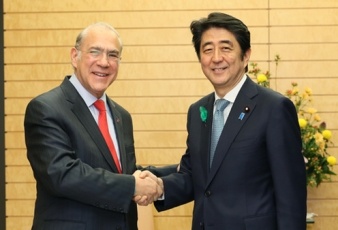
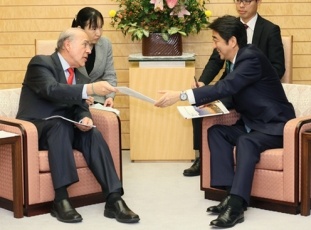
[Ministry of Economy, Trade and Industry] [Thursday, Apr 9, 2015]
METI Concluded an MOC with the State Government of Rajasthan, India, on Industrial Cooperation
On April 6, 2015, Mr. Yoichi Miyazawa, Minister of Economy, Trade and Industry, had a meeting with Ms. Vasundhara Raje, the Chief Minister of the State Government of Rajasthan, India, and both sides signed a Memorandum of Cooperation (MOC) on Industrial Cooperation in Rajasthan.
The conclusion of this MOC is part of the broader effort to achieve the goal of doubling Japan’s foreign direct investment and as well as the number of Japanese companies in India in five years, which was agreed upon at the Japan-India Summit Meeting in September of 2014. This is the second such initiative, following one with Andhra Pradesh, between the METI minister and the chief minister of a state in India.
Rajasthan has a variety of industrial advantages, including proximity to the National Capital Territory (NCT), the presence of a cluster of Japanese motor vehicle plants, and the fact that it is one of the major states in the industrial corridor that stretches from Delhi to Mumbai, all of which offer the state a high potential for investment.
Furthermore, the current Rajasthan Chief Minister Raje is well regarded for her efforts toward the development of industrial clusters, including the first industrial park dedicated to Japanese industries (Neemrana Industrial Park) through cooperation with JETRO when she was Rajasthan chief minister from 2003 to 2008, which in turn led to many Japanese companies opting to expand their business. Furthermore, Ghilot Industrial Park, a new industrial park dedicated to Japanese industries, is slated to be subdivided into lots for sale in the near future. Since her second inauguration in 2013, as the industrial sector called for the simplification of complex labor-related laws and deregulation, she revised the labor laws in favor of industry in October 2014, which was also well appreciated as a prompt response to the “Make in India” campaign initiated by the Modi administration.
The MOC includes the following points: METI and JETRO will support Japanese companies in developing their business in Rajasthan; the state government of Rajasthan will improve the business environment for Japanese industrial parks to meet global standards through the introduction of incentives and infrastructure development; and Japanese governmental organizations in India and the State Government of Rajasthan will launch a policy dialogue between them toward the development of the business environment. The conclusion of this MOC is expected to further accelerate Japanese companies’ development of their business in Rajasthan.
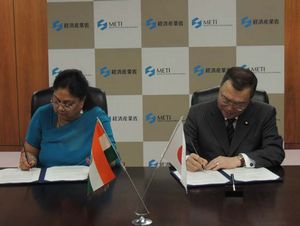
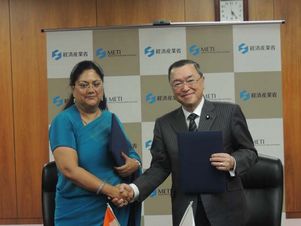
[Japan International Cooperation Agency] [Monday, Apr 13, 2015]
Tsubasa Bridge Opens in Cambodia, connecting Vietnam, Cambodia and Thailand with a Single Road
If you drive an hour and a half on Cambodia's National Road No.1, which runs along the Mekong River from the capital of Phnom Penh, you will spot a distinctive bridge. This is Tsubasa Bridge, for which an opening ceremony was held April 6.
The bridge, which was created over the course of more than 10 years since the beginning of the project in 2004 with Japan's cooperation, was named Tsubasa Bridge because it looks like two birds spreading their wings (tsubasa in Japanese) and holding hands. The name also expresses a wish for the further development of the relationship between Cambodia and Japan.
National Road No.1, which was built with the cooperation of Japan, is the most important arterial road in Cambodia and it connects with Ho Chi Minh City, Vietnam's largest city. However, until now the road was interrupted by the Mekong River in Neak Loeung, and a ferry was the only way to cross the river. The waiting time for a ferry was usually about 30 minutes, but during busy times, even with all three ferries running on full schedules, passengers were forced to wait seven or eight hours. And the ferries stopped operating at night. For users of National Road 1, this spot was a large bottleneck.
The main bridge of Tsubasa Bridge is 640 meters long, the entire bridge is 2,215 meters long, and including the attached road section, the total length is 5,400 meters. When the bridge opened April 6, users became able to cross the Mekong River using the road 24 hours a day. For neighboring residents, access to hospitals, schools, workplaces and the like was greatly improved.
The Asian Economic Community begins at the end of 2015 and the flow of people and goods across borders, not just within Cambodia, is expected to become increasingly active. Combined with National Road No.5, which also was supported by Japan, National Road No.1 will serve as a major artery supporting the economic growth of the Mekong region as a key point in the Greater Mekong Region Southern Economic Corridor, which connects Vietnam, Cambodia and Thailand.
Kampong Cham Province, located northeast of Phnom Penh, is home to the Kizuna Bridge, which was completed with Japan's cooperation in 2001. To commemorate the opening of Tsubasa Bridge, it now appears on the 500 riel bill along with Kizuna Bridge and the Cambodian and Japanese flags.
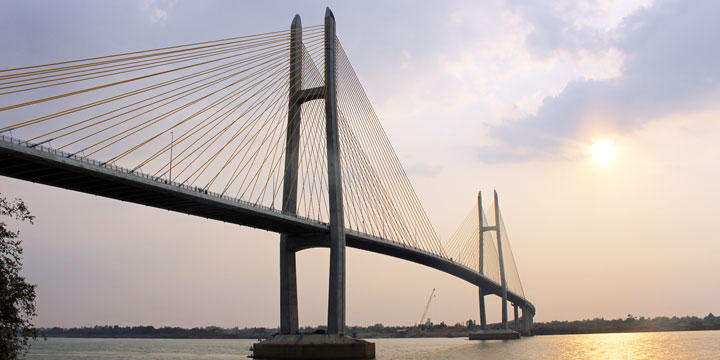
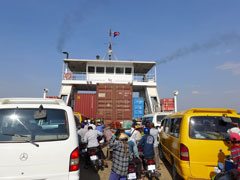
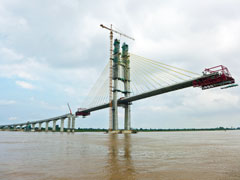
[Japan International Cooperation Agency] [Wednesday, Apr 15, 2015]
Signing R/D on "The Project for Development of a Comprehensive Disaster Resilience System and Collaboration Platform"
On 9 April 2015, Record of Discussion (R/D) for the new Technical Cooperation Project under SATREPS(*) scheme titled "The Project for Development of a Comprehensive Disaster Resilience System and Collaboration Platform" was signed by U Kyaw Zwa Soe, Director General of Department of Technology Promotion and Coordination, Ministry of Science and Technology, Prof. Dr. Aye Myint, Rector of Yangon Technological University, and Mr. Keiichiro NAKAZAWA, Chief Representative of JICA Myanmar Office. This project will be implemented by Department of Technology Promotion and Coordination (DTPC) under Ministry of Science and Technology and Yangon Technological University (YTU) in cooperation with Japan International Cooperation Agency (JICA).
This Project, which is the very first joint research project in Myanmar to be conducted between YTU and the University of Tokyo under SATREPS scheme, is targeting to develop the integrated disaster resilience systems consisting of software, hardware, and human resource development for strengthening Myanmar's disaster response ability and to establish collaboration platform among government, academia and industry. The experts from the University of Tokyo, Hokkaido University, Tohoku University, Keio University, and Hiroshima University in the relevant fields such as Water–related Disaster, Earthquake–related Disaster, Geospatial Technology, Infrastructure and Management, Transport and Mobility, and Disaster Management will be dispatched and work in the close cooperation with YTU and the concerned departments under Ministry of Science and Technology, Ministry of Transport, Ministry of Social Welfare, Relief and Resettlement, Ministry of Construction, and Ministry of Agriculture and Irrigation.
It is 5-years project and will be completed in 2020.
(*) SATREPS stands for "Science and Technology Research Partnership for Sustainable Development". SATREPS is targeting the human resource development and capacity-building of researchers and research institutions in developing countries, and development of new technology and applications as well as acquiring new knowledge through science and technology cooperation.